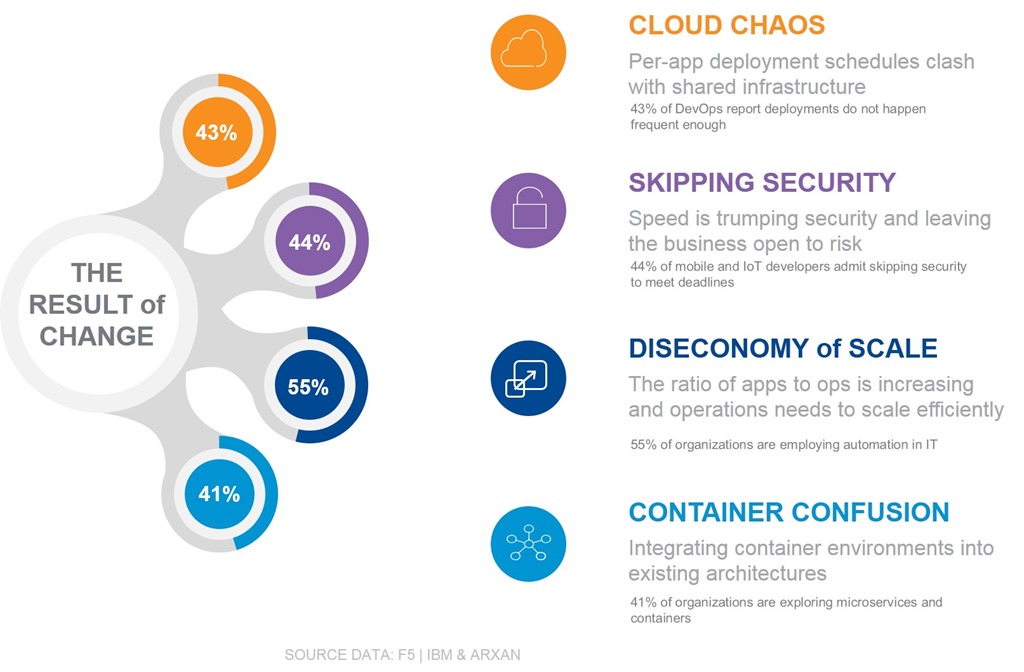デジタル トランスフォーメーションに関する意外な真実とそれがネットワークに与える影響
それは実際にはテクノロジーに関するものではありません。
唯一不変なのは変化だ* |
今日のテクノロジーにおける最大の変化は、インタラクションの変化です。 |
| *深遠な決まり文句は、それでも深遠である | テクノロジーがそれほど大きく変化しているというわけではなく、むしろテクノロジーとの関わり方が急速に変化しているのです。 |
マウスからタッチスクリーン、有線から無線、AVR から API、ボタンから音声まで。 今日、真に革新的なのは、人間とテクノロジーの間で実現される相互作用です。
技術的な観点から見ると、画面上のボタンのクリックを変換するメカニズムは、画面上の指のタッチを変換するメカニズムとそれほど違いはありません。 イベントはコードによって生成およびキャッチされ、その座標は、ユーザーが何をしようとしていたかを判断するアプリによって変換および解釈されます。 ここでは数学と三角法が関係してきます。システムは、イベントをトリガーした特定の座標がどの境界ボックス (ボタン) に含まれているかを判断するために必要な計算を実行します。
すると、出来上がり! 何かが起こります。
コアコード(何が起こったか)は変わりません。 それが引き起こされた方法だけです。 マウスのクリックの代わりに指で押します。 テキストの代わりに音声コマンド。 やりとりは変わりましたが、それ以外はほとんど変わりません。
これは IT 業界でも同様です。 ルータは変更されていません。 ファイアウォールも同様です。 applicationサービスは同じままです。 しかし、私たちがそれらと対話する方法、つまり CLI よりも API を、命令型よりも宣言型を、階層型アーキテクチャよりもクラウドを選択する方法が変わりつつあります。
そしてそれは変わらなければなりません。
なぜなら、applicationsは4年ごとに倍増するからです。 データ量は18か月ごとに倍増します。 OpEx は 8 年ごとに 2 倍になります。
これらすべての増加は、ビジネスのバックボーンであるネットワークに直接影響を及ぼします。 しかし、現在、その影響は、ポート密度の増加やバックプレーンの二重化、applicationサービスのスケール アウトといったプレッシャーだけではありません。 その影響は運用効率とネットワーク アーキテクチャに現れています。
デジタル トランスフォーメーションは、これまでのやり方を変えるチャンスです。 実際、これはチケットの処理と同じくらい優先度が高いと考えることもできます。 DevOps や Agile といった新しいアプローチや、クラウドやコンテナといった新しいデプロイメント環境によって状況は一変しましたが、それは単にそれらを使用しているからというだけではありません。 彼らは、アプリの開発、展開、配信方法に関するビジネスと開発の見方を微妙に変えてきました。 アプリごとのアーキテクチャが標準であり、これは NetOps の展開と配信にかかる運用上の負担に大きな影響を与えます。
驚くべき真実は、デジタル トランスフォーメーションはテクノロジーそのものよりも、テクノロジーとどのように関わり、適応してサポートするかが重要だということです。
しかし、そうするためには、実存的な影響が何であるかを知る必要があります。 そこで私は、デジタル トランスフォーメーションの結果として遭遇する可能性のある 4 つの最大の障害についてそれぞれ議論するブログ シリーズを開始することにしました。

クラウドの混沌– クラウドは、開発から展開、データ パスに至るまで、非常にアプリ中心の世界観をもたらしました。 各アプリには独自のプラットフォーム依存関係とパイプラインがあり、自由にデプロイできると想定しています。 これは、安定した共有インフラストラクチャの必要性と衝突します。
セキュリティを省略する– ビジネスの期限に間に合わせる必要があり、セキュリティが邪魔になる場合、どちらが優先されると思いますか? 私たちは常にこの問題を抱えていました。パフォーマンスが悪い場合は、セキュリティをオフにしてください。 侵害のリスクがかつてないほど高まっている今、それが進行中です。
規模の不経済– デプロイ数減少の法則に抵触する前に、増加するアプリ数に対処するために雇用できるオペレーターの数には限りがあります。
コンテナの混乱– コンテナが登場し、ほぼ半数の組織がコンテナを検討しており、すでにかなりの組織がコンテナを本番環境に導入しています。 コンテナ環境 (ミニクラウドのような環境) を既存のインフラストラクチャと統合するのは難しい場合があります。
これら 4 つの課題により、ネットワークが曇り空でコンテナ化された混乱の渦に巻き込まれる恐れがあります。 そして、それが他の人に起こるのを見るのは病的なほど興味深いかもしれませんが、最終的にはあなたも巻き込まれるでしょう。 どのような影響があるのか、そしてそれに対して何をすべきかを知っておくことで、うまく乗り越えられる可能性が高まります。
今後数週間にわたって私たちがこれらの課題に正面から取り組む様子にご注目ください。
